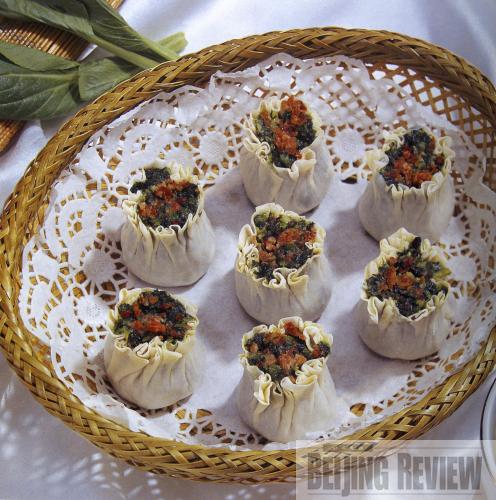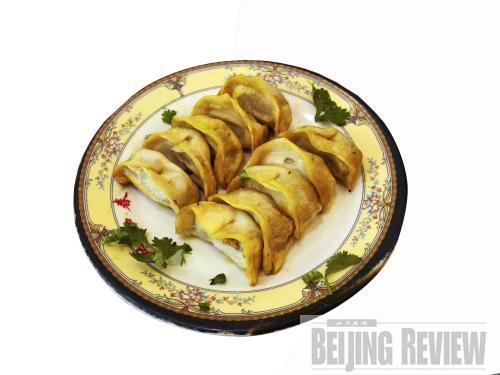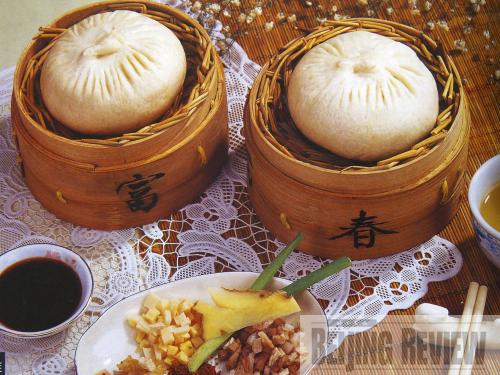|
 |
| Yangzhou fried rice (CFP) |
The first step in my Chinese culinary odyssey through Yangzhou City, east China's Jiangsu Province, began at Gonghechun, a locally famous restaurant visible from the street only with a banner of golden letters on a field of red. We were greeted inside by an unremarkable, cafeteria-like eatery.
More remarkable, however, was the food. Soft sanding buns were first up, at once tastier and fresher than most steamed buns—the tender chicken and pork mingled with bamboo shoots, producing a distinctive taste. Their juices seeped into the freshness of the attendant bun.
For 10 yuan ($1.47), meanwhile, we enjoyed a generous helping of the old, traditional Yangzhou fried rice. Offering a fresh, playful alternative to the far greasier fare Americans have long been accustomed to, this particular dish comes with tender ham, eggs, mushrooms, shrimp, green beans and carrots.
Tasty, fried dumpling-style morsels called guotie were also on order for 3 yuan ($0.44). Though slightly greasier, these beef treats were wrapped in a dumpling and also delicious.
 |
| Yangzhou Shaomai, a traditional dumpling (CFP) |
We next tried a helping of xiehuang tangbao, a cluster of crab roe soup dumplings that cost us 8 yuan ($1.18). It was a sweet, almost dessert-like panache that added to the afternoon's proceedings.
Some say that the U.S. east coast state of Maryland boasts the best crabs anywhere in North America. Nonetheless, the crab powder roe that perfects these helpings of noodles, dumplings and steamed buns in Yangzhou's cuisine simply cannot be ignored by anyone.
A few hours later, we were still full, but our appetite for Yangzhou cuisine was hardly diminished. We were greeted at Yiyuan Restaurant, one of the city's most prestigious eateries by Lu Guangfei, a local television food show producer.
With Lu clad in a traditional Chinese-style outfit, we sat astride a panoramic view of the bustling, neon-lit city center below. The dishes spread out on the table before us were just as appealing.
The first two dishes that caught my eye were the plain-seeming, though very tasty, luxianggu—a plate of marinated, medallion-shaped mushrooms. We also spotted the local shizitou, which are meatballs made of pork and crab roe.
Another dish looked slightly suspect to the untrained Western eye. I thought it was a plate of string beans at first blush, but a closer look made me think they were anchovies, or some kind of fish.
The real answer, however, surprised me—not just because the slivers of dark, nondescript and wet meat turned out to be the best dish on the table: They were finless eels. They had a consistency combining fish and liver and were infused with a sweet, mild taste.
 |
| Guotie, fried dumpling-style morsels (CFP) |
"We have a history that goes back 2,500 years," our bespectacled host enthused about his city of 1.1 million people, as we all dove in surgically with our chopsticks. "But food here is becoming more diverse, because people have more needs and can afford it—it's more nutritious."
The reward for our curiosity also included a heaping plate of sliced tofu. But this was not just any tofu, it was tofu Yangzhou-style. It was unlike any tofu I had ever tasted before. Fine and stringy, it was succulent in a way that made it reminiscent of a finely aged French soft cheese like Brie.
Last, but certainly not least, we enjoyed a local fish delicacy named Stewed Silver Carp Head. Retrieved from the fabled Yangtze River nearby, it was saturated in soybean oil that almost tasted like butter. It was at once sumptuous, smooth and tender.
In short, it was unlike any fish I had ever tasted before.
|

|
|
Fuchun steamed buns with fillings, popular snacks in Yangzhou (CFP) |
After polishing off our plates, our host brought us to a nearby shimmering canal. It was only slightly chilly in the dark of the early evening. The canal was aglow with the lights of nearby houses and a passing ferry of tourists from elsewhere in China.
Our host rounded out the evening by singing for us his own informal, yet exquisite, rendition of the Kunqu Opera, one of the oldest forms of opera still existing in China, with an origin that dates back to the Yuan Dynasty (1271-1368).
Just before we parted company, there was one basic thing I had forgotten to ask about the delicious cuisine of Lu's favorite city: What's the secret?
He did not pause and offered his final food for thought. "We just use simple materials to make good food," he said and smiled. | 
